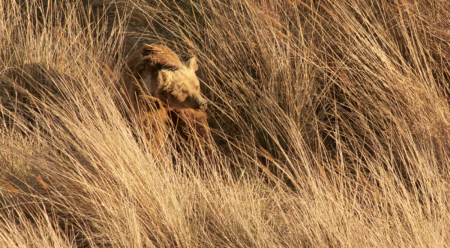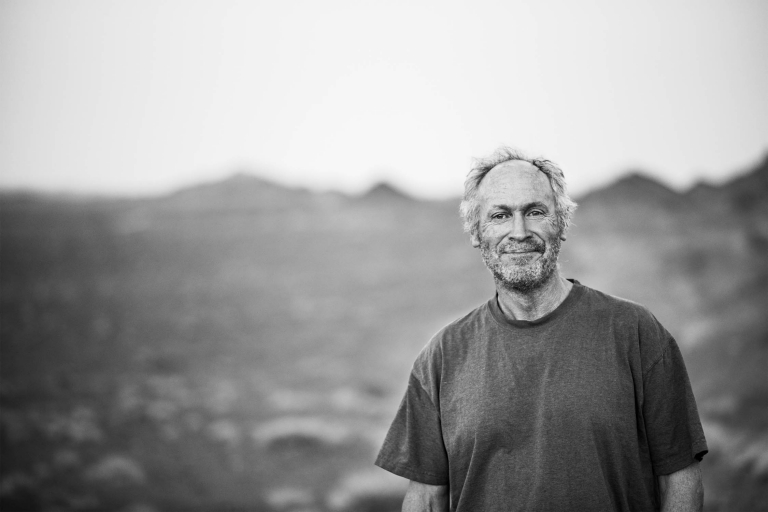Tracking Gobi Grizzlies
Today, we’re happy to share an excerpt from Douglas Chadwick’s new book, Tracking Gobi Grizzlies: Surviving Beyond the Back of Beyond, published by Patagonia Books. The following story appears in chapter nine, Big Bawa.
We set out later in the morning in two vans, one to get water from the pool at the Suujiin Bulag spring, the other to check the two remaining oases with traps farther north. The first van was leaking oil from the differential. Ankhaa planned to fix it later in the day. The other van had a broken starter jury-rigged to operate until it, too, could be properly repaired. It took any number of tries to get the thing to fire up. Before separating, we had to stop by the big cairns at the foot of the rubble slope below Tsagaan Bogd and make offerings to the mountain spirits. Whereas the early morning was a study in silence, coveys of chukars had since taken over the stage, walking, flying in short whirring bursts, clucking, and pitchoo-wichoo-ing on all sides. They added a background chorus to our ceremony of asking the powers atop the peak to help all the life here thrive.
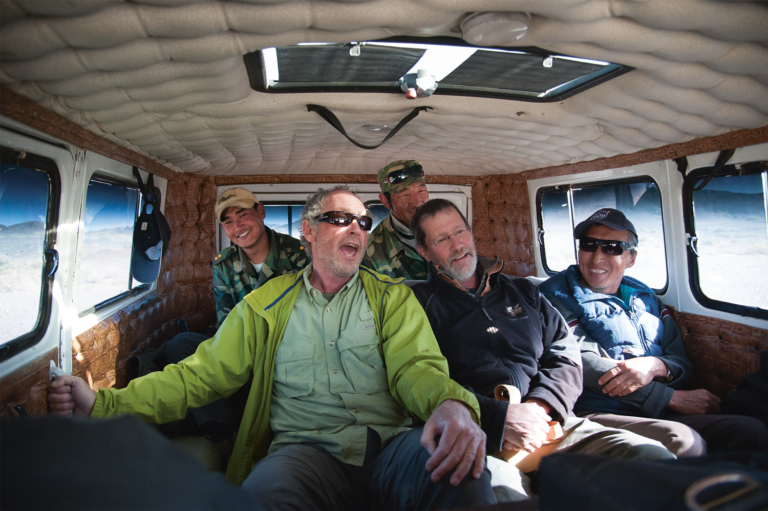
On some of the longer van journeys to check distant portions of the bears’ range, a curious mixture of Mongolian ballads and American rock music can be heard. In fact, there’s no escaping it. Photo: Joe Riis
This beseeching business really worked well. Why don’t I do it more often? The trap at Muktar Zadgai didn’t simply have a bear; it was filled with a bear. We wouldn’t know the age or sex for sure until the drugs Harry injected it with kicked in, but this was one hefty mazaalai. By the time the animal succumbed to the sedatives, the sun was high and the day, a rare windless one, had grown awfully hot. We dragged the bear out and laid it close to the side of the metal box so that most of its body rested in the trap’s narrow rectangle of shade. A normal body temperature for a grizzly bear is around 101 degrees F. Using a rectal thermometer, Harry got a reading higher than that and immediately directed several of us to bring water from the spring, which came out of the ground chilled that time of year. Moving quickly, we hauled jugs of it back to splash onto the bare skin around the captive’s groin—it was a male—and the “armpits” where his front legs met the side of his chest, just as one would do for a human threatened with hyperthermia. Next, we poured water onto the bear’s coat and rubbed it in through the outer hairs and dense underfur to be sure it reached the skin. Before we quit, we had essentially given our captive a coldwater bath.
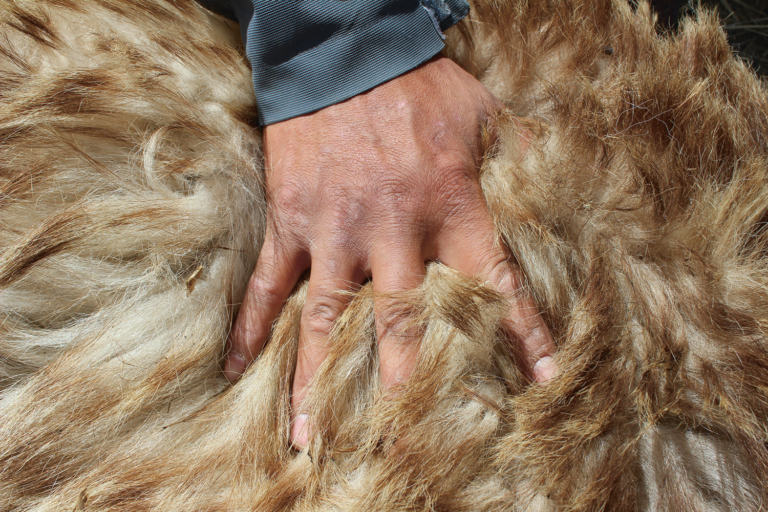
Because mazaalai can neither burrow into hillsides in the Gobi stonescape nor amass insulating fat due to their meager diet, they rely on thick outer fur and dense underfur to provide insulation while hibernating through the cold winter, often partly exposed in caves. Photo: Doug Chadwick
There was a lot of bear to wash. The crew arranged a rope harness around the male and attached it to the lower hook of a weight scale. The upper hook was then tied to a pole about five feet long. Two rangers, one at each end of the pole, lifted it into the air. A little way. Two more crew members grabbed on to help. It was still a struggle to get the bear high enough off the ground that his head and legs swung freely in the air. Others on the team crowded in to lend an arm. The scale only read up to 150 kilograms. That wasn’t quite enough. The mass of our bear pulled the marker half an inch beyond the last number. Harry estimated the animal’s weight at 155 to 160 kilograms—at least 350 pounds.
The largest bear previously documented in the study was the male named Yokozuna, after the champion sumo-style wrestlers. This was the bear that helped dissuade Mongolian authorities from opening up part of the reserve to gold mining years earlier. The locations from Yokozuna’s collar left no doubt that his range extended into the proposed mining area. A bear the size of the new male might well range between all three mountain complexes, too. The way I saw it, the most important thing he had to tell us and the Mongolian government was that the desert reserve, left uncompromised by development, could grow truly big, fat, strong, and healthy mazaalai. And that boded well for the future of the population as a whole. Look at him!
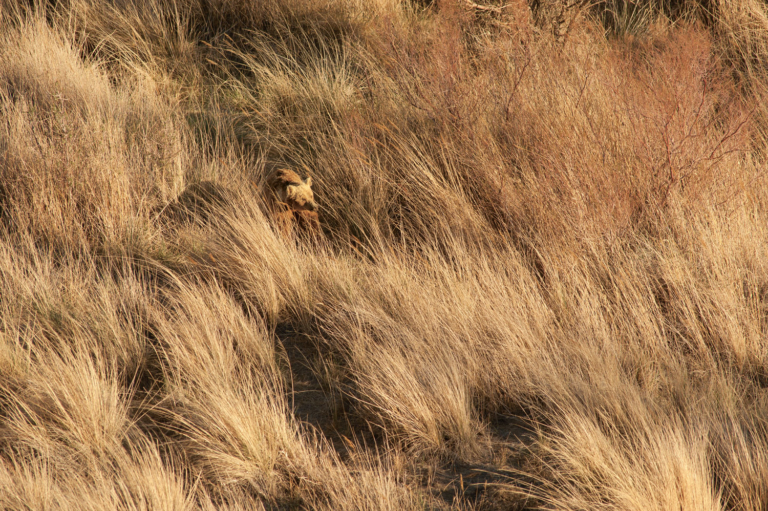
Big Bawa among the Phragmites grasses at the oasis where he was radio-collared. Photo: Joe Riis
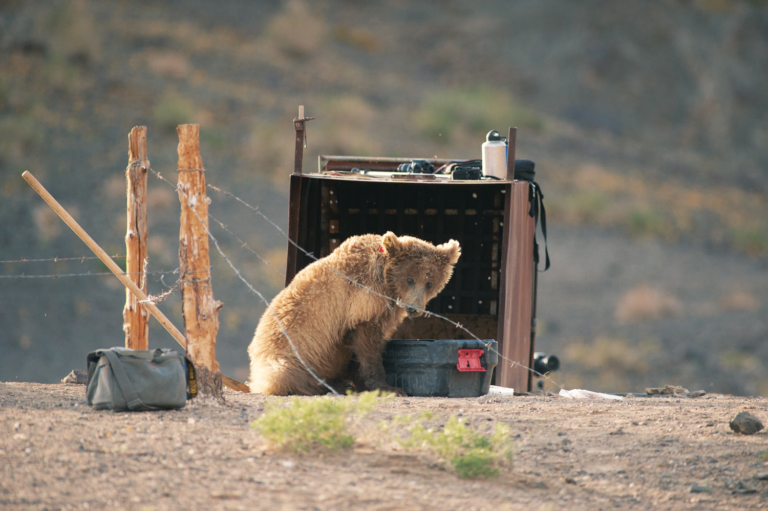
Recovering from the sedative, a just-collared female Gobi bear rests by the uplifted trap door. The equipment containers near her were abandoned by the fleeing research crew when she first stood up—far sooner than expected. Photo: Joe Riis
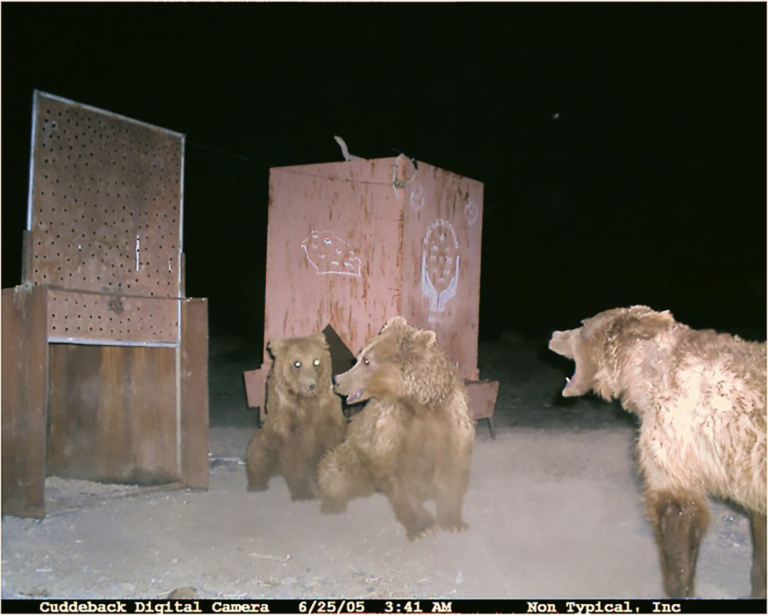
One of the automatic cameras deployed at the feeders caught this mother bear defending her subadult youngster from a larger bear. Photo courtesy of Gobi Bear Project
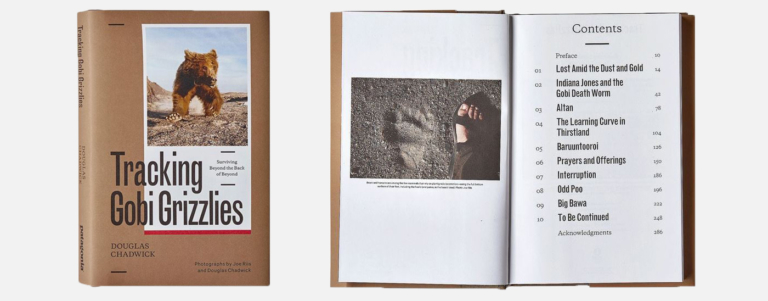
Tracking Gobi Grizzlies: Surviving Beyond the Back of Beyond, by Douglas Chadwick
In the tradition of Douglas Chadwick’s best-selling adventure memoir, The Wolverine Way, his new book, Tracking Gobi Grizzlies, creates a portrait of these rarest of bears’ fight for survival in one of the toughest, most remote settings on Earth. He demonstrates why saving this endangered animal supports an entire ecosystem made up of hundreds of interconnected plants and animals, from desert roses to Asiatic lynx and wild double-humped camels, all adapting as best they can to the effects of climate change. A parable of environmental stewardship in a legendary realm. Available now at patagonia.com.
